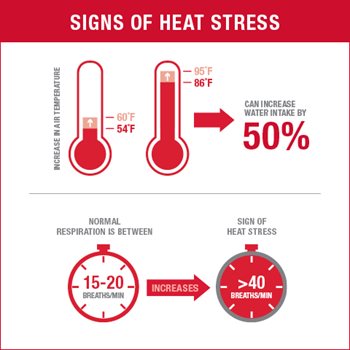
Focus on Sow Nutrition to Combat Summer Heat Stress
Sow : Sow Production

Motherhood is never easy, but for sows can get even harder during hot summer weather.
Heat stress sets off a cascade of events for the sow: First, monitor sows more often during hot weather and know what to look for. Visible signs of heat stress in sows include:
First, monitor sows more often during hot weather and know what to look for. Visible signs of heat stress in sows include:
A nutrient-dense, reduced-fiber ration can help speed up digestion, improve digestive efficiency and create less heat during the process. Include higher levels of fat from sources such as tallow, choice white grease or vegetable oil at 2-6% in place of fibrous ingredients.
Maintaining optimal body condition score (BCS) through all stages of production can help sows perform to their full potential in extreme heat.1, 2 Purina® Push® sow feed or NEWtraStart™ feed contain dense energy sources and additives to support digestion. These feeds can help the sow eat enough to support milk production and maintain body condition at the same time.
Research showed Push® supported more weaned pigs and heavier weaned pigs without negatively impacting sow body condition.
At just 70 degrees Fahrenheit, sow feed intake can start to decline from heat stress. Fine-tuning management practices and rations to help sows handle heat stress can pay off in more consistent performance potential for sows and their pigs.
Which one of these feeding strategies will you implement for your sows?
Tap into your local Purina representative’s expertise to learn more.
1 Rozeboom, K.J., M. Todd See and W. Flowers. “Management practices to reduce the impact of seasonal infertility on sow herd productivity.” North Carolina Cooperative Extension Service. Publication No. ANS00-8138. http://www.ncsu.edu/project/swine_extension/publications/factsheets/813s.htm. 5 May 2013.
Heat stress sets off a cascade of events for the sow:
- Body temperature regulation kicks in, pulling a sow’s energy away from body condition maintenance and milk production.
- At the same time, feed intake typically drops, which causes a sow’s body to prioritize lactation over body condition maintenance.
- The combined result? Sows can lose condition quickly, putting them at risk for slow breed back and inhibiting future performance.
Know and Watch for Signs of Sow Heat Stress
 First, monitor sows more often during hot weather and know what to look for. Visible signs of heat stress in sows include:
First, monitor sows more often during hot weather and know what to look for. Visible signs of heat stress in sows include:
- Sprawling to maximize contact with the cooler floor
- Reduced physical activity
- Seeking water to cool the skin
- Sows taking more than 40 breaths per minute; normal respiration is 15-25 breaths per minute
Make up for Lost Intake and Body Condition with Sow Nutrition
Feed sows a palatable, concentrated source of energy to compensate for reduced intake, and be sure sows have access to fresh, clean water.A nutrient-dense, reduced-fiber ration can help speed up digestion, improve digestive efficiency and create less heat during the process. Include higher levels of fat from sources such as tallow, choice white grease or vegetable oil at 2-6% in place of fibrous ingredients.
Maintaining optimal body condition score (BCS) through all stages of production can help sows perform to their full potential in extreme heat.1, 2 Purina® Push® sow feed or NEWtraStart™ feed contain dense energy sources and additives to support digestion. These feeds can help the sow eat enough to support milk production and maintain body condition at the same time.
Research showed Push® supported more weaned pigs and heavier weaned pigs without negatively impacting sow body condition.
Give the Sow a Hand with Creep Feeding
Nursing large litters for 21 days can take a toll. Take pressure off sows by supplementing with a high-quality creep feed like UltraCare® creep in the last week of lactation. Creep feeding can lessen the demand on the sow and prevent excessive loss of sow body condition. It also supports pig growth for optimal weaning weight. Purina Animal Nutrition research shows every one pound gained at weaning correlated to nearly four additional pounds at finishing.3At just 70 degrees Fahrenheit, sow feed intake can start to decline from heat stress. Fine-tuning management practices and rations to help sows handle heat stress can pay off in more consistent performance potential for sows and their pigs.
Which one of these feeding strategies will you implement for your sows?
Tap into your local Purina representative’s expertise to learn more.
1 Rozeboom, K.J., M. Todd See and W. Flowers. “Management practices to reduce the impact of seasonal infertility on sow herd productivity.” North Carolina Cooperative Extension Service. Publication No. ANS00-8138. http://www.ncsu.edu/project/swine_extension/publications/factsheets/813s.htm. 5 May 2013.
2 Whitney, Mark. “Minimizing heat stress in pigs during the summer.” University of Minnesota Extension. http://www.extension.umn.edu/swine/components/pubs/Whitney-MinimizingHeatStress.pdf. 5 May 2013
3 De Rodas, B., Correlation of Weaning Numbers to Finishing Productivity. Summary of data from Purina Animal Nutrition Center. August 14, 2015.

.png?width=300&height=430&ext=.png)

